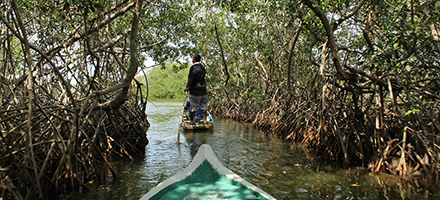
The fishing community of Cispatá Bay on the coast of Colombia might seem like the unlikely site of an investment for Apple. But the tech giant, which is funding the protection of a 27,000-acre mangrove forest in the area, sees it as a strategic part of its fight to mitigate climate change. Source: Fast Company
Forests are an effective and low-cost way to capture CO2 at a time when new technology designed to do the same thing–like machines that can mechanically suck carbon from the air–is still in its infancy and costly. Mangrove forests are particularly effective.
“Mangrove forests can absorb and store up to 10 times more carbon than a terrestrial forest,” said Lisa Jackson, the company’s vice president of environmental, social, and policy initiatives, who previously served as the head of the Obama-era EPA.
“And, globally, we’ve lost half of the world’s mangrove forests since the 1940s, so it’s high time we start preserving and protecting them.”
The company is making progress in cutting its own emissions. A year ago, it announced that it had reached a goal of powering all of its operations with 100% renewable electricity. It’s convinced more than 40 of its suppliers to make the same commitment.
It’s designing new ways to recycle products, like a robot that can disassemble 200 iPhones in an hour; eventually, it could use materials in a closed loop rather than relying on suppliers to mine new natural resources. But investing in forests can help the company cut global carbon while technology and processes are still improving.
The project in Colombia, which Apple began working on last year and wrote about in more detail today, is not its first investment in forests. In China, Apple partnered with World Wildlife Fund to help one million acres of forest transition to better management practices, and is working to help the Chinese government update forest management guidelines for the entire country. In the US, it worked with The Conservation Fund, which buys working forests and helps them become certified as sustainably managed and protected into the future.
In Colombia, it recognized the unique opportunity of working with mangroves.
If you want to change the thermostat of the planet in a meaningful way in your own lifetime, probably the best thing you can do is end the destruction of mangroves,” says M. Sanjayan, CEO of Conservation International, the nonprofit working with Apple on the project.
When the trees are chopped down–something that happens both for the use of the wood and to expand farming and fishing–they emit the carbon that they have stored for centuries. In a year, as much as one billion metric tons of CO2 are released from degraded coastal ecosystems
“About 6% of global emissions come from the destruction of this tiny sliver of a habitat, this forest that clings onto the edge of oceans in tropical systems around the world,” says Sanjayan. Ending the destruction of mangroves worldwide would be the equivalent of entirely eliminating the emissions of France and German.
But the organization estimates that only about 2% of funding for climate mitigation goes to nature-based solutions, despite the fact that those solutions are an important addition to other changes like the shift to renewable energy.
An analysis in 2017 led by The Nature Conservancy estimated that stopping deforestation, improving forest management practices, and restoring forests could remove around 7 billion tons of emissions from the atmosphere annually, more than the pollution from every car on the planet.
Another analysis this year looked at the impact of planting trees in existing parks, forests, and abandoned land, and concluded there was room to plant 1.2 billion trillion new trees, enough to absorb perhaps a decade’s worth of human emissions.
Apple’s funding in Colombia is also helping Conservation International work with the Colombia-based Invemar Research Institute to accurately measure the amount of carbon stored in trees, plants, and soil.
That will make it possible to sell carbon offsets under the Verified Carbon Standard–the first time that an ocean or coastal ecosystem has sold a carbon offset for what is known as the “blue carbon” stored in coastal plants and soil. Other methods in the past have focused on the carbon stored above ground, but the soil is actually the most critical part of the ecosystem.
The project can help incentivize the local community to protect the forest.
“The funding really goes to support communities,” says Sanjayan. “And from Apple’s perspective, that’s actually kind of an important part of the picture. These aren’t mangroves in national parks. These are mangroves that are really in working communities.”
The community collects seafood like crabs and clams from around the roots of the trees, and keeping the trees intact protects their livelihoods.
The trees also double as a climate adaptation tool. As climate change makes storms more intense and sea levels rise, the forest can help provide some protection to homes near the shore. It’s the type of work that other companies should consider, he says.
“I would love to see what happened to plastics happen to deforestation,” he says. “Businesses are all of a sudden really tuned into the issue of plastics. We need to make the same thing happen with deforestation.”
In many cases, that means working harder to avoid deforestation in the supply chain, whether companies are sourcing palm oil (for use in shampoo, or lipstick, or instant noodles, or ice cream) or beef, soy, or other products produced in former rainforests. But it can also mean separately funding the protection of rainforests even if a company’s own products may be unrelated.
“This is rare for Apple to say, but we are telling other companies to copy us on this,” says Jackson. “We hope that by showing we can successfully apply the same innovation that goes into our products to our efforts to protect the environment, other companies will be encouraged to take action.”







